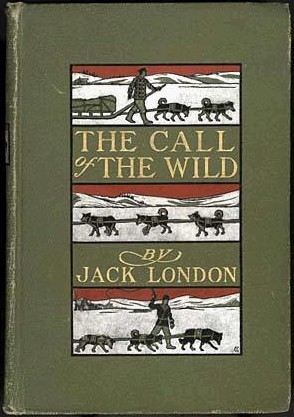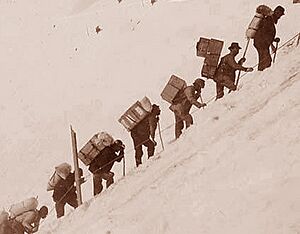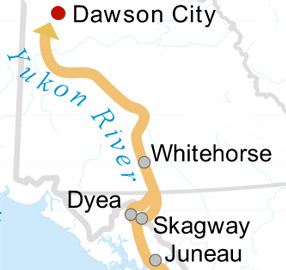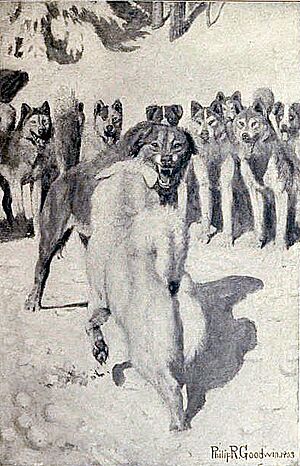The Call of the Wild facts for kids

First edition cover
|
|
| Author | Jack London |
|---|---|
| Illustrator | Philip R. Goodwin and Charles Livingston Bull |
| Cover artist | Charles Edward Hooper |
| Country | United States |
| Language | English |
| Genre | Adventure fiction |
| Set in | Santa Clara Valley and the Yukon, c. 1896–99 |
| Publisher | Macmillan |
|
Publication date
|
1903 |
| Media type | Print (Serial, Hardcover & Paperback) |
| Pages | 232 (First edition) |
| OCLC | 28228581 |
| 813.4 | |
| LC Class | PS3523 .O46 |
The Call of the Wild is an exciting adventure novel by Jack London. It was published in 1903. The story takes place in the Yukon, Canada, during the 1890s. This was the time of the Klondike Gold Rush, when strong sled dogs were needed a lot.
The main character is a dog named Buck. The story begins at a ranch in Santa Clara Valley, California. Buck is stolen from his home and sold to work as a sled dog in Alaska. He slowly becomes more wild in the harsh environment. He has to fight to survive and become the leader of other dogs. By the end, he lets go of his "civilized" ways. He uses his natural instincts and what he has learned to become a leader in the wild.
Jack London spent almost a year in the Yukon. His experiences there helped him write much of the book. The story was first printed in parts in The Saturday Evening Post in the summer of 1903. It was then published as a book later that year. The book became very popular and made Jack London famous. The story was made into a movie as early as 1923. Many other movies have been made since then.
One famous early movie was made in 1935. It starred Clark Gable and Loretta Young. This movie changed the story quite a bit. Charlton Heston starred in the 1972 movie version. Many people said this version was the most like the book.
Contents
Story Summary
The story starts in 1897 with Buck. He is a strong, 140-pound dog. He is a mix of St. Bernard and Scotch Shepherd. Buck lives happily in California's Santa Clara Valley. He is the loved pet of Judge Miller and his family.
One night, an assistant gardener named Manuel steals Buck. Manuel needs money to pay off his gambling debts. Buck is sent to Seattle. There, he is kept in a crate, starved, and treated badly. When he is let out, Buck attacks the "man in the red sweater." This man teaches Buck the "law of club and fang." This means that humans are stronger than dogs. The man shows some kindness after Buck learns to obey.
Soon after, Buck is sold to two French-Canadian mail carriers. Their names are François and Perrault. They take him to Alaska. Buck is trained to be a sled dog for the Klondike region of Canada. François and Perrault have ten other dogs on their team. These dogs teach Buck how to survive cold winter nights. They also teach him about how dogs live together in a pack.
Over the next few weeks, a big rivalry grows between Buck and the lead dog, Spitz. Spitz is a mean and quarrelsome white husky. Buck eventually kills Spitz in a fight. Buck then becomes the new lead dog.
François and Perrault finish their trip on the Yukon Trail very quickly. They return to Skagway with their messages. They get new orders from the Canadian government. They sell their sled team to a "Scotch half-breed" man. This man works for the mail service. The dogs have to make long, tiring trips. They carry heavy loads to the mining areas.
While on the trail, Buck seems to have memories of a dog ancestor. This ancestor had a short, "hairy man" companion. The tired dogs become weak from the hard work. Dave, a sad husky, gets very sick. He is eventually shot because he cannot go on.
The mail carrier sells the dogs because they are too tired and sore. He sells them to three gold seekers from the American South. Their names are Mercedes, her quiet husband Charles, and her proud brother Hal. They do not know how to survive in the Northern wilderness. They struggle to control the sled. They ignore helpful advice from others. They especially ignore warnings about the dangerous spring melt.
When told her sled is too heavy, Mercedes throws out important supplies. She keeps fashion items instead. She and Hal foolishly make a team of 14 dogs. They think more dogs will make them go faster. The dogs are first overfed and overworked. Then they are starved when food runs low. Most of the dogs die on the trail. Only Buck and four other dogs are left when they reach the White River.
The group meets John Thornton, an experienced outdoorsman. He sees how weak and sick the dogs are. The three new owners ignore Thornton's warnings about crossing the ice. They push on. Buck is exhausted, starving, and senses danger. He refuses to go on. Hal whips Buck without mercy. A disgusted and angry Thornton hits Hal and cuts Buck free. The group goes on with the four remaining dogs. But their weight makes the ice break. The dogs and humans fall into the river and drown.
Thornton helps Buck get healthy again. Buck grows to love him very much. Buck kills a mean man named Burton. He tears out Burton's throat because Burton hit Thornton. This makes Buck famous all over the North. Buck also saves Thornton when he falls into a river.
Thornton takes Buck on trips to pan for gold. A rich gold miner named Mr. Matthewson bets Thornton on Buck's strength and loyalty. Buck pulls a sled with a half-ton (1,000 pounds) of flour. He pulls it free from the frozen ground. He drags it 100 yards. This wins Thornton US$1,600 in gold dust. Another rich miner offers a lot of money to buy Buck. But Thornton refuses.
Using his winnings, Thornton pays his debts. But he decides to keep looking for gold with his friends Pete and Hans. They sled Buck and six other dogs to find a famous Lost Cabin. Once they find gold, the dogs have nothing to do. Buck has more memories of his ancestors. He remembers being with the primitive "hairy man."
While Thornton and his friends pan for gold, Buck hears the "call of the wild." He explores the wilderness. He makes friends with a northwestern wolf from a local pack. But Buck does not join the wolves. He returns to Thornton. Buck goes back and forth between Thornton and the wild. He is not sure where he belongs.
One day, Buck returns to the campsite. He finds that Hans, Pete, and Thornton have been killed by Native American Yeehats. Buck is very angry. He kills several Natives to get revenge for Thornton. Then he realizes he has no human ties left. He looks for his wild brother. He meets a hostile wolf pack. He fights them and wins. Then he finds out that the lone wolf he befriended is a member of this pack. Buck follows the pack into the forest. He answers the call of the wild.
The story of Buck spreads among other Native Americans. He is known as the "Ghost Dog" of the Northland. Each year, on the day he attacked the Yeehats, Buck returns to the old campsite. He goes there to remember Thornton. Every winter, Buck leads the wolf pack. He gets revenge on the Yeehats. He "sings a song of the younger world, which is the song of the pack."
Main Characters
Major Dog Characters
- Buck: He is the main character of the novel. He is a 140-pound mix of St. Bernard and Scotch Collie. He lived happily in California with Judge Miller. But he was stolen and sold to the Klondike. He was forced to work as a sled dog in the harsh Yukon. He eventually finds a loving owner named John Thornton. Buck slowly becomes wild as he gets used to the wilderness. He finally joins a wolf pack. After Thornton dies, Buck is free of humans forever. He becomes a legend in the Klondike.
- Spitz: He is the first bad guy in the novel and Buck's main enemy. He is a white-haired husky from Spitsbergen. He was a lead sled dog for a long time. He sees Buck's unusual ability to adapt to the North as a threat. He keeps trying to start fights with Buck.
- Dave: He is the 'wheel dog' at the back of the dog team. He is brought North with Buck and Spitz. He is a loyal sled dog who just wants to be left alone. He wants to be led by a good lead dog. He gets very weak on his second trip on the Yukon Trail. But the men let him keep pulling the sled because he is proud. He becomes so weak that he is put down (euthanized).
- Curly: A large Newfoundland dog who was killed by wild huskies.
- Billee: A kind, gentle husky who pulls the sled faithfully. He is worked to death by Hal, Charles, and Mercedes.
- Dolly: A strong husky bought by Francois and Perrault. Dolly is badly hurt by an attack from wild dogs. Later, she gets rabies and attacks the other sled dogs, including Buck. Francois stops her madness by hitting her head.
- Joe: Billee's brother, but he is the opposite. He is grumpy and keeps to himself. Spitz cannot control him. But Buck, after becoming the team leader, makes him behave.
- Sol-leks ('The Angry One'): A one-eyed husky who does not like anyone coming from his blind side. Like Dave, he expects nothing and gives nothing. He only cares about being left alone and having a good lead dog.
- Pike: A smart dog who pretends to be sick and steals food.
- Dub: A clumsy dog who always gets caught.
- Teek and Koona: Other huskies on the Yukon Trail dog-team.
- Skeet and Nig: Two dogs from the South owned by John Thornton when he gets Buck.
- The Wild Brother: A lone wolf who becomes friends with Buck.
Major Human Characters
- Judge Miller: Buck's first owner. He lived in California with his family. He showed friendship to Buck.
- Manuel: Judge Miller's worker who sells Buck to the Klondike. He does this to pay off his gambling debts.
- The Man in the Red Sweater: A trainer who beats Buck. He teaches Buck that humans are in charge.
- Perrault: A "swarthy" French-Canadian mail carrier for the Canadian government. He is Buck's first owner in the Northland.
- François: A French-Canadian "half-breed" and Perrault's partner. He is the musher who drives the sled dogs.
- Hal: An aggressive and violent musher. He is Mercedes' brother and Charles' brother-in-law. He does not know how to handle sled dogs.
- Charles: Mercedes' husband. He is less violent than Hal.
- Mercedes: A spoiled and pampered woman. She is Hal's sister and Charles' wife.
- John Thornton: A gold hunter who is Buck's last owner. He is killed by the Yeehats.
- Pete and Hans: John Thornton's two partners. They pan for gold with him.
- The Yeehats: A tribe of Native Americans. After they kill John Thornton, Buck attacks them. He forever "dogs" them after becoming wild. This makes sure they never enter the valley where his last owner was killed.
Background of the Story
Jack London was from California. He had traveled around the United States as a hobo. He went back to California to finish high school. He had dropped out at age 14. He spent a year in college at Berkeley. Then, in 1897, he went to the Klondike through Alaska. This was during the peak of the Klondike Gold Rush. Later, he said about this time: "It was in the Klondike I found myself."
He left California in July. He traveled by boat to Dyea, Alaska. From there, he went inland. To reach the goldfields, he and his group carried their gear over the Chilkoot Pass. They often carried loads as heavy as 100 pounds on their backs. They found success by claiming eight gold mines along the Stewart River.
London stayed in the Klondike for almost a year. He lived for a short time in the frontier town of Dawson City. Then he moved to a nearby winter camp. He spent the winter there in a temporary shelter. He read books he had brought, like Charles Darwin's On the Origin of Species and John Milton's Paradise Lost. In the winter of 1898, Dawson City had about 30,000 miners, a saloon, and an opera house.
In the spring, new gold seekers started to arrive. London left then. He had gotten scurvy. This was common in Arctic winters because fresh food was not available. When his gums started to swell, he decided to go back to California. With his friends, he rafted 2,000 miles down the Yukon River. They went through some of the wildest parts of the region. They reached St. Michael. There, he worked on a boat to earn his way back to San Francisco.
In Alaska, London found the ideas that inspired him to write The Call of the Wild. Dyea Beach was the main place miners arrived when London was there. But because it was hard to get to, Skagway soon became the new arrival point. To reach the Klondike, miners had to go through White Pass. This was known as "Dead Horse Pass." Horse bodies were all over the route because they could not survive the harsh, steep climb. Dogs replaced horses as pack animals to carry things over the pass. Strong dogs with thick fur were "much desired, scarce and high in price."
London would have seen many dogs. He especially saw prized husky sled dogs in Dawson City and the winter camps. These camps were close to the main sled route. He was friends with Marshall Latham Bond and his brother Louis Whitford Bond. They owned a mixed St. Bernard-Scotch Collie dog. London later wrote about this dog: "Yes, Buck is based on your dog at Dawson." The Beinecke Library at Yale University has a photo of Bond's dog. It was taken when London was in the Klondike in 1897. The description of the California ranch at the start of the story was based on the Bond family ranch.
How the Book Was Published
When London returned to California, he could not find work. He did odd jobs like cutting grass. He sent a letter to the San Francisco Bulletin. He suggested writing a story about his Alaskan adventure. But the idea was rejected. The editor told him, "Interest in Alaska has subsided to an amazing degree."
A few years later, London wrote a short story about a dog named Bâtard. At the end of that story, the dog kills his owner. London sold this story to Cosmopolitan Magazine. It was published in June 1902 as "Diablo – A Dog." London's biographer, Earle Labor, says London then started The Call of the Wild. He wanted to "redeem the species" from his dark picture of dogs in "Bâtard."
London thought he would write a short story. He explained: "I meant it to be a companion to my other dog story 'Bâtard' ... but it got away from me, and instead of 4,000 words it ran 32,000 before I could call a halt."
The Call of the Wild was written as a frontier story about the gold rush. It was meant for popular magazines. It was first published in four parts in The Saturday Evening Post. They bought it for $750 in 1903. In the same year, London sold all rights to the story to Macmillan. They published it as a book. The book has been printed continuously ever since.
Different Editions
- The first edition was by Macmillan. It came out in August 1903. It had 10 color pictures by Philip R. Goodwin and Charles Livingston Bull. It also had a color picture at the front by Charles Edward Hooper. It sold for $1.50. You can find it with the original pictures at the Internet Archive.
What Kind of Story Is It?
The Call of the Wild is an adventure fiction story. It is also an "animal story." In this type of story, the author tries to write about an animal character. They do this without making the animal too much like a human.
The story is also an example of American pastoralism. This is a common idea in American literature. It means a hero goes back to nature. Like other characters in American literature, such as Rip van Winkle and Huckleberry Finn, Buck shows a reaction against factories and strict social rules. He returns to nature. London shows this idea simply and powerfully in the story. This idea was later used by 20th-century American writers like William Faulkner and Ernest Hemingway.
Images for kids
-
The Call of the Wild (cover of the June 20, 1903 The Saturday Evening Post) is about the survival of the fittest.
See also
 In Spanish: La llamada de la selva (libro) para niños
In Spanish: La llamada de la selva (libro) para niños






